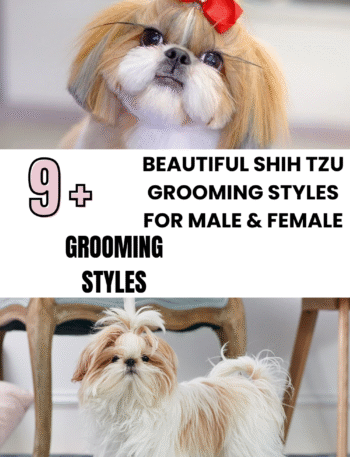Introduction: Meet the Regal, Quirky Shih Tzu
The Shih Tzu is no ordinary dog. Revered as “Little Lion Dogs,” these pint-sized pups once roamed the palaces of Chinese emperors and are now one of the most adored companion breeds across the globe. With their luscious coats, bold personalities, and affectionate nature, Shih Tzus stand out as a timeless breed, equal parts royalty and cuddle buddy.
But there’s far more to this ancient breed than their unmistakable cuteness. In this comprehensive guide, we’ll dive deep into 30 fascinating, lesser-known, and expert-backed facts about the Shih Tzu. Whether you’re a seasoned owner or a curious pet lover, these facts will enhance your understanding and appreciation for this unique toy breed.
Let’s explore what makes the Shih Tzu not just a pet—but a lifelong companion with an extraordinary legacy.
🏯 1–5: Ancient Roots and Cultural Significance
1. Shih Tzus Are Over 1,000 Years Old
Originating in Tibet and perfected in Imperial China, the Shih Tzu has one of the most ancient canine bloodlines. They were gifts from Tibetan monks to Chinese emperors, believed to bring good fortune.
2. Their Name Means “Lion Dog”
“Shih Tzu” is Mandarin for “Lion Dog,” inspired by the Buddhist symbol of the lion as a guardian and protector. Despite their cuddly appearance, they were bred to symbolize power.
3. The Breed Was Almost Lost Forever
During China’s communist revolution, Shih Tzus nearly went extinct. Every modern Shih Tzu today descends from just 14 dogs—a genetic bottleneck that saved the breed.
4. They Were Exclusively Palace Dogs
For centuries, Shih Tzus lived only within royal courts. Commoners were forbidden to own or breed them. They had personal servants and were sometimes trained to warm emperors’ feet.
5. Western Recognition Came Late
Although introduced to Europe in the early 20th century, the American Kennel Club didn’t officially recognize the breed until 1969—after World War II soldiers brought them back from Asia.
🐕 6–10: Physical and Coat Characteristics
6. Double Coat, Double the Grooming
Shih Tzus have a unique double coat: a soft undercoat beneath a longer outer layer. While elegant, it requires daily brushing to prevent mats and tangles.
7. Hypoallergenic? Technically Yes
Shih Tzus don’t shed like other breeds. Their hair falls out slowly, reducing allergens—making them ideal for people with mild pet allergies.
8. Their Face Structure Is Brachycephalic
Flat-faced and short-nosed, Shih Tzus are prone to snorting, snoring, and heat sensitivity. Their unique skull shape adds to their charm but requires attentive care.
9. Undershot Bite Is the Breed Standard
Shih Tzus naturally have an undershot jaw, where the lower teeth sit in front of the upper teeth. While it gives them a “smiling” look, dental care is critical.
10. Their Eyes Are Oversized for a Reason
Large, round, and expressive—those iconic eyes were intentionally bred to look like chrysanthemums, a revered flower in Chinese culture.
✂️ 11–15: Grooming Needs and Styling Facts
11. Daily Grooming Is Non-Negotiable
Long-haired Shih Tzus must be brushed every day. Even short-coated ones benefit from regular combing to avoid mats, particularly behind the ears and around the legs.
12. Professional Grooming Is a Lifelong Necessity
On average, Shih Tzus require professional grooming every 3–4 weeks. Skipping appointments leads to matting, ear infections, and skin issues.
13. Over 30 Recognized Haircut Styles
The breed is famously versatile in grooming. Styles like the teddy bear cut, puppy cut, top knot, and lion cut allow for creative expression.
14. Eye Discharge Must Be Cleaned Daily
Their prominent eyes produce regular discharge, which can stain fur and cause infections. Use damp cotton pads to gently clean the area.
15. Bathing Frequency Depends on Coat Length
A long-haired Shih Tzu needs a bath every 7–10 days, while short-haired varieties may go 2–3 weeks. Always use a dog-specific, tear-free shampoo.
❤️ 16–20: Personality and Temperament
16. Shih Tzus Are True Companions
Bred solely to be lapdogs, they thrive on human companionship. Don’t expect them to herd sheep or fetch balls—they’re here to love and be loved.
17. Surprisingly Stubborn
Training a Shih Tzu requires patience. They’re intelligent but independent, and can appear aloof when asked to do something they dislike.
18. Not Yappy, But Alert
They don’t bark excessively but will alert you to unfamiliar sounds. Their calm demeanor makes them ideal apartment dogs.
19. Adaptable to All Lifestyles
Shih Tzus can live happily in city apartments or country homes. They enjoy short walks but are just as happy lounging all day.
20. Excellent with Children and Seniors
Gentle, calm, and affectionate—they’re great with kids (when treated gently) and thrive in households with elderly owners.
🏥 21–25: Health, Genetics, and Lifespan
21. Shih Tzus Have a Long Lifespan
With proper care, they typically live 12–16 years, and some reach 18+. Regular vet visits and a clean diet are essential.
22. Common Genetic Issues to Watch
Shih Tzus are prone to:
- Intervertebral Disc Disease (IVDD)
- Hip Dysplasia
- Eye ulcers and dry eye
- Brachycephalic Syndrome
- Dental crowding and tartar buildup
23. Overheating Is a Serious Threat
Due to their short noses, they overheat quickly in warm weather. Limit outdoor time in summer and always provide shade and water.
24. Weight Gain Comes Easily
Their small size makes even slight weight gain dangerous. Avoid overfeeding, and use low-calorie treats during training.
25. Oral Health Shouldn’t Be Ignored
Dental decay is one of the most overlooked issues in this breed. Begin tooth brushing early and schedule yearly dental cleanings.
🏡 26–30: Unique Lifestyle and Fun Facts
26. Shih Tzus Love a Routine
They prefer consistency in feeding times, sleep, walks, and even furniture placement. Sudden change may cause stress or anxiety.
27. Low Exercise, High Affection
They don’t need vigorous workouts. Two short walks a day and some indoor play are enough to keep them healthy.
28. Excellent Therapy Dogs
Thanks to their calm nature and empathy, many Shih Tzus are trained as therapy dogs in nursing homes, hospitals, and schools.
29. They Don’t Like to Be Alone
Leaving a Shih Tzu home alone for too long can lead to separation anxiety, depression, or destructive behavior.
30. Shih Tzus Are One of the Most Recognized Toy Breeds Worldwide
Regularly featured in global dog shows, TV commercials, and social media, their popularity continues to rise due to their versatility, charm, and joyful spirit.
🧠 FAQs About Shih Tzus
Do Shih Tzus bark a lot?
They are moderate barkers. They’ll alert you to noises but are not compulsive barkers like some terriers.
Are Shih Tzus easy to potty train?
Not exactly. Their stubborn streak makes them one of the trickier small breeds to housetrain. Crate training helps immensely.
Can Shih Tzus live with other pets?
Yes! They’re generally friendly and do well with cats and other dogs when introduced properly.
How often should a Shih Tzu visit the vet?
At least once a year for healthy adults; seniors or dogs with chronic conditions may need visits every 6 months.
Do Shih Tzus smell bad?
Not naturally. A foul smell typically signals a skin infection, dental issue, or poor grooming.
✅ Conclusion: The Little Lion With a Big Heart
Shih Tzus are living proof that good things come in small, furry packages. Behind their dainty looks and royal lineage lies a dog full of affection, loyalty, humor, and surprising resilience. They require a bit of upkeep, yes—but the love and companionship they offer are well worth it.
Whether you’re thinking of bringing one home or deepening your knowledge as an owner, these 30 facts give you a well-rounded, expert-level understanding of this majestic breed.
Want to learn more? Check out our other in-depth guides:
- How to Groom a Shih Tzu at Home
- Top 30 Shih Tzu Grooming Styles
- Low-Calorie Treats for Small Breeds
- Shih Tzu Lifespan: 19 Factors That Matter




